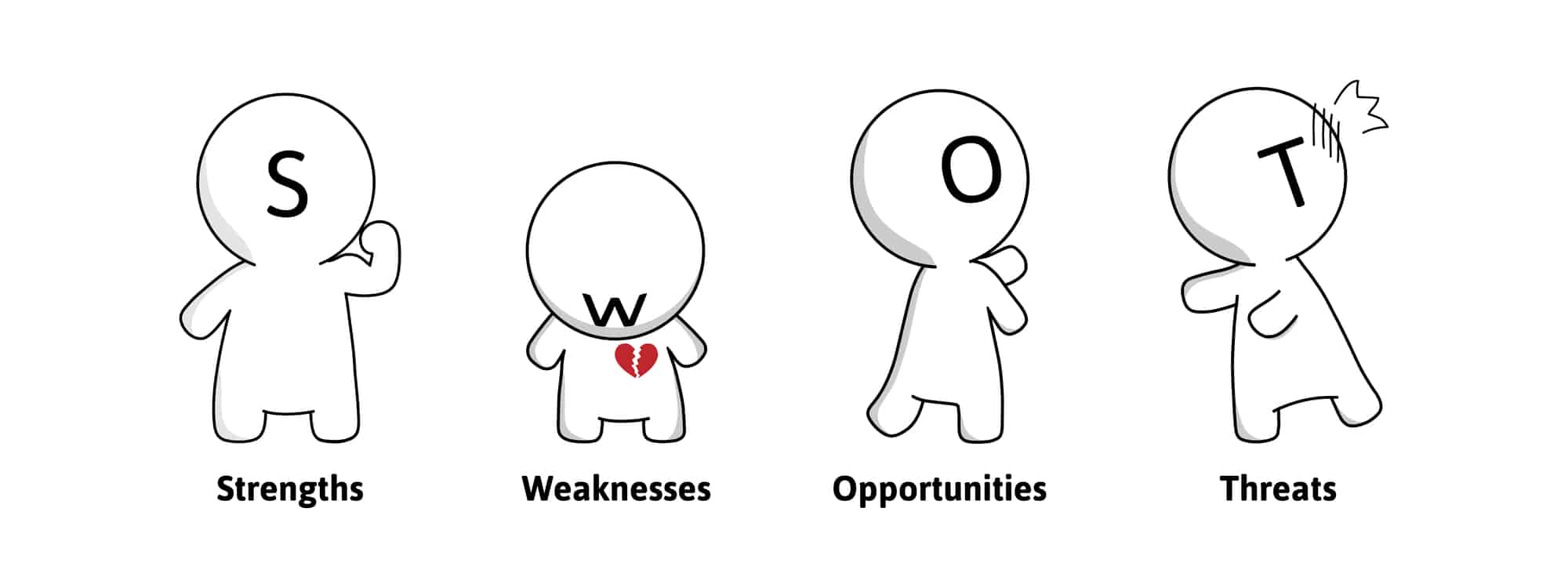Do you know that every business faces threats from both internal and external environments? You must think, then, how do businesses overcome these threats and ensure smooth operations?
Well, the answer to that is simple. Businesses identify the potential threats in advance and then form strategies to mitigate the damage associated with those threats.
However, the question arises: How do businesses identify their potential threats? Businesses identify their threats by using SWOT analysis.
SWOT analysis is a tool used by businesses to identify their weaknesses and strengths. Moreover, SWOT analysis also highlights business opportunities and threats an organization faces.
If used correctly, a SWOT analysis can provide volumes of information about the circumstances which an organization or venture finds itself. One of the handy benefits of using a SWOT analysis (as opposed to other business analysis tools) is its inherent simplicity -- all there is to do is list the Strengths, Weaknesses, Opportunities, and Threats, and you’ll find yourself with plenty of worthy insight.

However, it’s not always so simple. This is true, especially when you are unsure what fits explicitly into each S, W, O, and T category. For that reason, we’ve decided to write this series of articles about each of the letters in the acronym, including what they mean and include.
This article is the fourth installment in the series and will be focusing on the definition and examples of Threats in a SWOT analysis table. If you haven’t already, be sure to familiarize yourself with Strengths, Weaknesses, and Opportunities first.
In today's article, we will analyze the threats section of the SWOT analysis and discuss the SWOT analysis threat examples. There are two main types of threats that an organization faces.
One is the internal threat, and the other is the external threat. This article will discuss all the threats businesses face from the external and internal environments.
T is for Threats: Definition
In business analysis, Threats are anything that could cause damage to your organization, venture, or product. This could include anything from other companies (who might intrude on your market) to supply shortages (which might prevent you from manufacturing a product).
Threats are negative and can be both external and internal. This means that threats do not benefit your company, but there is nothing you can do to stop them from coming about.
Threats are like opportunities in that you cannot change their frequency or purposefully bring them about, but you can still choose how to approach and deal with them.
Threats: Why include them?
Unforeseen threats can mean horrible things for any company, which is why it’s essential to take them into account in SWOT analysis. Thankfully, if you can predict them, it’s possible to reduce their impact or avoid them entirely.

External Threats
External threats are the threats that a business faces from the external environment. These threats can be avoided if businesses form effective strategies to mitigate their adverse effects.
SWOT analysis highlights the external threats that businesses might face in advance. This helps businesses form strategies in advance to avoid the damage caused by these threats. Let's look at some of the external threats businesses face.
Competition
Businesses feel threatened by high competition since it leads to low profits. Let's analyze why businesses consider a high level of competition a threat.
Market Saturation
Market saturation refers to the situation when too many players are in a market. Due to market saturation, players are unable to dominate the market. Moreover, competition often leads to price wars.
For example, several players are competing in the smartphone industry. Due to so many players, the market share is divided among them.
Emerging Competitors
The emergence of new competitors causes the demand for existing players to fall. Moreover, as new players enter the market, the existing dynamics of the market are disturbed.
For example, traditional taxi services faced challenges when new ride-sharing platforms like Uber emerged. New platforms snatched the market share of traditional taxi services.
Technological Disruption
Rapid advancements in technology can act as a threat to existing businesses. Technologies such as AI and blockchain impact traditional model businesses. For example, streaming platforms like Netflix have affected cable TV companies.
Market Trends
Market trends refer to changing trends related to demand, consumer taste, etc. Let's discuss why businesses feel threatened by various market trends.
Changing Consumer Preferences
Consumer preferences keep changing due to cultural, social, and economic reasons. Changing consumer preferences act as a challenge for businesses. If a business cannot adapt to the changing consumer preferences, the business might be pushed out of the industry.
A recent example of the change in consumer preferences would be a shift toward healthy eating habits. This change has made it challenging for fast-food chains to adapt.
Economic Downturns
Economic downturns, such as recessions, can change the pattern of consumer spending. Economic recessions may cause the demand to fall. This will cause the profits of businesses in the market to fall. For example, during the economic crisis of 2008, car manufacturers faced reduced demand.
Regulatory Changes
Changes in regulations can cause market trends to change immediately. Regulatory changes can create challenges for businesses. For example, a sudden ban on plastic packaging can cause businesses to suffer losses.
Industry Threats
Industry threats refer to the threats the entire industry faces from the external environment. Let's take a look at some of the industry-related threats.
Supply Chain Disruptions
A supply chain can be disrupted for various reasons, such as geopolitical tensions and transportation issues. Due to disruptions in the supply chain, a shortage of products can occur, and delays in the production process can occur. For example, the shortage of semiconductors recently caused delays in car manufacturing.
Globalisation Impact
Globalization creates opportunities and challenges at the same time. For example, globalization has caused competition to increase since producers worldwide compete. Moreover, the change in trade policies in one country impacts the rest of the world.
Globalization has integrated the world, due to which political instability in one country also affects the demand or supply of products in another country.
Natural Disasters And Climate Change
Natural disasters can affect industries negatively. For example, if roads get blocked due to natural calamities, the supply chain of businesses will get disrupted. Similarly, if there are sea storms due to climate change, shipments might get delayed.
This is how natural disasters and climate change can have a damaging impact on the operations of businesses.

Internal Threats
SWOT analysis also highlights the internal threats that are present for businesses. Internal threats refer to the threats that arise from within the business. Let's take a look at some of the internal threats.
Operational Risks
Operational risks are the risks associated with the operations of a business. In this section, we will look at some of the threats linked to the operations of a business.
Inefficient Processes
Internal operations of businesses should be efficient. If the internal processes are inefficient, the business's productivity will be hindered, and the production cost will increase. Overall, the consumers will also be dissatisfied if the internal processes of a business are inefficient.
For example, a manufacturing plant with inefficient machinery won't be able to meet customer demand efficiently.
Lack of Innovation
A lack of innovation can be damaging for a business. It can hinder the growth of the business. Suppose a business is unable to keep up with the advancements in innovation, then it may lose its market share to its competitors.
For example, Kodak failed to keep up with the innovation, and as a result, other brands, such as Canon, captured its market share.
Resource Limitation
Limitation of resources impacts the operations of businesses in an industry. For example, if a business has fewer financial or technological resources, it would be difficult for such a business to compete in the market.
Human Resource
Human resources (HR) is a significant portion of a business. There are several internal threats related to HR that a business faces. Let's analyze some of the threats related to HR.
Workforce Skills Gap
A business must have a skilled workforce. If the workforce is less skilled, it becomes difficult for a business to compete. Hence, businesses need a skilled workforce; otherwise, they will be pushed out of the industry.
Employee Turnover
A high turnover rate creates problems for businesses. A business with a high turnover rate spends a lot of money on hiring employees, which increases the business's costs. Moreover, a high employee turnover rate damages a business's reputation, making it difficult for such a business to find a talented workforce.
Leadership Challenges
The performance of a business is dependent on the quality of leadership available to a business. Suppose the head of a business is not visionary and doesn't believe in innovation; it will be impossible for a business to grow.
Financial Threats
Financial threats are a form of an internal threat that businesses face. Financial constraints impact the performance of a business negatively. In this section, we will look at how financial threats affect businesses.
Cash Flow Issues
A business faces cash flow issues when there is a deficit between incoming and outgoing cash. Cash flow problems arise due to delayed payments, excessive expenses, or changes in revenue volume. Cash flow problems can delay payments and disrupt a business's supply chain.
Budget Constraint
Budget constraint refers to the limitation of financial funds. If a business has budget constraints, it won't be able to spend freely on R&D and technology. As a result, the growth of such businesses will be affected.
Debt And Financial Obligations
Repayment of loans and interest interest payments can pile up to pose a threat to the company's financial health. Excessive financial obligations may cause problems in cash flow. Moreover, excessive debt levels may lead to financial instability.

Examples of Threats in SWOT Analysis of Various Industries
What follows are both general and specific examples of threats that might appear in a SWOT analysis.
General Examples:
- The introduction of a better alternative for an impersonal product: if a company has been selling the same product for years without ever making any effort to interact with its customers and build trust, then the introduction of a better alternative could be called a threat. This is because a portion of the company’s current market could switch to the alternative, causing them to lose out on profits.
- New laws for parody artists: if new laws were to state that parodying popular entertainment (in the form of art) for commercial purposes is illegal, then this would undoubtedly be a significant threat to those whose careers rely on the practice.
Specific Examples:
- New entrants in mobile tech for Apple: Apple’s mobile products have long been the go-to choice for many consumers. However, many companies, such as Samsung, Huawei, and Sony, have been introducing viable alternatives to the iPhone and iPad. If these products gain much traction, Apple will find themselves losing a “piece of the pie”.
- The rise of cheaper energy drinks for Redbull and Monster: many new energy drinks have begun stacking up on shelves across the globe -- and they are often cheaper than household names like Red Bull and Monster. This could be considered a threat as price-conscious consumers might start switching to cheaper options.
- More mobile-friendly social networks for Facebook: companies like Snapchat and Tiktok have taken a new approach to social networking, with a focus on the accessibility of mobile phones. Snapchat has already replaced Facebook in plenty of social scenarios, while Tiktok has been a direct competitor to Google's offering worth billions, YouTube.
Different industries face different types of threats. In this section, we will highlight the threats that different industries face.
Technology Sector
The technology sector is an essential part of every economy. It comprises different businesses developing, manufacturing, and distributing technology-based products. Let's discuss the threats that the technology sector faces.
Disruption By New Entrants
In the technology sector, new entrants can snatch the market share of already existing businesses by introducing innovative products. For example, Tesla is a relatively new car manufacturing company.
However, it has quickly captured a significant market share since it manufactures electric vehicles.
Cyber Security Threats
Tech companies face constant threats of data breaches and cyber-attacks. In case the data of a tech company is leaked, the company will have to face lawsuits, and its reputation will also be damaged.
Rapid Technological Changes
Businesses in the tech industry constantly feel threatened by rapid technological changes because if a business fails to keep up with technological innovation, it can lose its market share and customer base.
Retail Industry
The retail industry is another major industry of every economy. Let's proceed further and look at what threats businesses in the retail industry face.
E-Commerce Competition
As the e-commerce industry has grown, the competition among online retailers has increased. Businesses in the retail sector need to find USPs to distinguish themselves from others.
For example, a new entrant in the e-commerce industry may find it really difficult to settle due to the high level of competition.
Shifting Consumer Behavior
Consumer behavior is constantly changing due to cultural shifts and economic conditions. Businesses need to understand the behavior of the consumers to perform well in the market.
Supply Chain Vulnerabilities
The supply chain can be disrupted due to climatic reasons or political conflicts. Disruption of the supply chain causes production delays and increases the production cost. Hence, businesses feel threatened by the disruption of the supply chain.
Healthcare Sector
Businesses in the healthcare sector also feel threatened by various external factors. Let's take a look at the factors that threaten businesses in the healthcare sector.
Regulatory Changes
The healthcare sector is always highly regulated. Changes in the regulations and policies of the health sector can affect the operations of pharmaceutical companies and nursing homes. Regulatory changes may increase the cost of existing businesses in the healthcare sector.
Technological Integration Changes
Introducing new technologies can cause unemployment since the existing workforce may not know how to use the new technology. Moreover, it can lead to inefficiency since the existing workforce will take time to learn how to operate the new technology.
Furthermore, introducing new technology will increase the risks of data breaches and cyber-attacks.
Rising Costs And Reimbursement Issues
The healthcare sector often struggles with rising costs. The rise in operational costs minimizes the profits of businesses in the healthcare sector. Moreover, reimbursement issues can impact the financial stability of healthcare providers.

Strategies To Mitigate Threats
Different strategies are present to mitigate the threats that businesses in different industries face. Let's analyze different threat-mitigating strategies.
Risk Management Framework
The risk management framework refers to conducting regular assessments to identify and manage risks.
Innovation And Adaptation
Focusing on innovation and adapting the latest technologies and trends help businesses to stay ahead of their competitors. Hence, innovation can help businesses in mitigating threats.
Strategic Partnerships And Collaborations
Strategic partnerships and collaborations help organizations pile up their resources to form a strategy to mitigate threats. Collaboration can provide access to new markets, which will cause the market share and customer base to increase.
Diversification of Products/Services
Diversification of products and services helps businesses in mitigating threats. For example, if the demand for soft drinks falls, Pepsi can generate revenue by selling juices or other snacks.
Continuous Monitoring And Evaluation
Continuous monitoring helps organizations identify new trends and highlight potential threats promptly. Once the threats are identified promptly, it becomes easy for businesses to form effective strategies to counter them.
Threats in SWOT Analysis: Final Thoughts
In conclusion, threats are a negative, external and internal occurrence that should be included in every SWOT analysis. Taking them into account can help in making the best decisions, and not doing so can cause sudden damage. In today’s dynamic markets, every company (including the biggest ones) faces a number of different threats.









